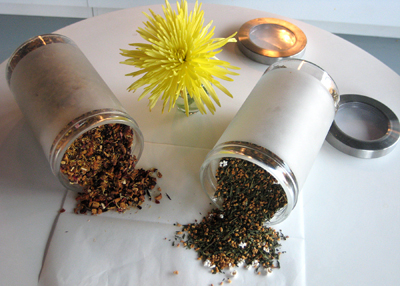By Mallie Majarais
 Let’s discuss the popularity (and inferiority) of commercial teabags. Nowadays, tea bags make up about 95% of all tea sales in the US. These bags, however, usually contain the cheapest tea available, producing little more than a brown-colored liquid. Doesn’t sound too appetizing, huh? With this as the popular standard, it’s not surprising that tea’s popularity has faded.
Let’s discuss the popularity (and inferiority) of commercial teabags. Nowadays, tea bags make up about 95% of all tea sales in the US. These bags, however, usually contain the cheapest tea available, producing little more than a brown-colored liquid. Doesn’t sound too appetizing, huh? With this as the popular standard, it’s not surprising that tea’s popularity has faded.
When the first leaf fell in Shen Nung’s cup, did it have a labeled string attached? We think not. For centuries, tea was enjoyed in a loose form, employing a variety of different methods to separate the leaves from the water. The first tea bags were inadvertently made from hand-sewn silk muslin bags. Thomas Sullivan, a tea and coffee merchant from New York City, tried to cut sampling costs by sending loose tea in small silk sacks. Potential clients, confused by this new packaging, threw the tea in hot water— bag and all. Thomas started getting many requests for these “teabags” and realized that he Photo: Carlos Paes had struck gold. The quick and easy clean up of the leaves (due to the fact that they were still contained in the silk bag) made it enticingly convenient. Teabags first began appearing commercially around 1904, and quickly shipped around the world.
 Unfortunately, however, this convenience came at a high price: flavor. using bags created the problem of improper expansion of leaves. In order for a tealeaf to fully infuse all flavors possible, it needs a great deal of room to expand. Because teas in teabags got less legroom, the quality was diminished. What was the solution? Smaller leaves. This way, they needed less room to enlarge. Because size no longer mattered, merchants could use much cheaper grades of tea known as “fannings” or “dust.” These are the lowest rankings that tea can achieve; found at the bottom of the tea barrels-sure, they’ll add color to your cup, but not nearly as much flavor. Most supermarkets still offer only a bottom-of-the barrel tea product, leaving most consumers to believe that there is nothing better available. But this is a far cry from the flavor and aroma found in a cup of full-leaf gourmet tea.
Unfortunately, however, this convenience came at a high price: flavor. using bags created the problem of improper expansion of leaves. In order for a tealeaf to fully infuse all flavors possible, it needs a great deal of room to expand. Because teas in teabags got less legroom, the quality was diminished. What was the solution? Smaller leaves. This way, they needed less room to enlarge. Because size no longer mattered, merchants could use much cheaper grades of tea known as “fannings” or “dust.” These are the lowest rankings that tea can achieve; found at the bottom of the tea barrels-sure, they’ll add color to your cup, but not nearly as much flavor. Most supermarkets still offer only a bottom-of-the barrel tea product, leaving most consumers to believe that there is nothing better available. But this is a far cry from the flavor and aroma found in a cup of full-leaf gourmet tea.
A complete renovation of the Western mindset on tea may seem like a long shot, but remember this: there once was a time when your choice of coffee ranged from Folgers to Sanka. Then, Starbucks came along to show how much better it can be. The same is true of tea. Most folks are no longer drinking Sanka. Once they try gourmet-quality tea, they will not wish to drink anything currently sold in the supermarket either.
O-CHA tea bar sells and serves only high quality, loose leaf gourmet teas. Come in to see our wide variety today! Tea accessories, to properly steep your tea, are always available. Tea makes an excellent holiday gift! Gift baskets available with a two day notice.


